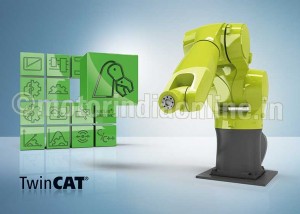Beckhoff’s TwinCAT Kinematic Transformation enables machine manufacturers and users to control robots and their own kinematic constructions directly from within the TwinCAT software platform. This function has been further developed so that highly complex kinematics can also be implemented.

TwinCAT Kinematic Transformation offers numerous kinematics that are divided into three different product levels, depending on their complexity. These include 2-D, shear, 3-D delta and SCARA kinematics. The new Level 4 version represents a consistent extension of the range of functions, now also allowing more complex kinematics to be implemented. Examples are serial 6-axis kinematics and the Steward platform.
TwinCAT performs the set value generation and necessary kinematic transformations. The set values for the axes are cyclically transferred via EtherCAT to the drive amplifier, e.g., an AX5000 servo drive. The robot movements are programmed directly from the PLC. Path movements for the following of contours can, of course, also be implemented with TwinCAT NC I according to DIN 66025.
With TwinCAT Kinematic Transformation, an additional robot controller, and thus the learning of a special robot programming language, is not required. Accordingly, the entire machine can be operated with just one control CPU.